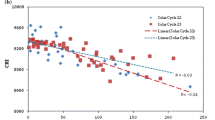Abstract
A new method is proposed to predict cosmic ray intensity and solar modulation parameters. The method is coupled with the McNish and Lincoln method, which predicts first smoothed sunspot numbers. The error achieved is estimated and compared with the same chain of predictions using two other methods developed for US and Russian space applications. The three methods give satisfactory results when applied, for example, to prediction of the dose received on-board commercial aeroplane flights.
Similar content being viewed by others
References
Badhwar, G. D.: 2001, private communication.
Badhwar, G. D. and O'Neill, P. M.: 1993, 23th Int. Cosmic Ray Conf. 3, 535.
Badhwar, G. D. and O'Neill, P. M.: 1996, Adv. Space Res. 17(2), 7.
Badhwar, G. D., O'Neill, P. M., Cucinotta, F. A., and Weyland, M.: 1995, 24th Int. Cosmic Ray Conf. 4, 1118.
Commission of European Communities Council Directive 96/29/Euratom/ of 13 May 1996, Official Journal of EC, Series L, No 159 of 1996.
Conway, A. J.: 1998, New Astron. Rev. 42, 343.
Fessant, F., Pierret, C., and Lantos, P.: 1996, Solar Phys. 168, 423.
Freidberg, W., Copeland, K., Duke, F. E., O'Brien, K., and Darden, E. B.: 1999, Radiat. Prot. Dosim. 86, 323.
Hildner, E. and Greer, M. S.: 1989, Proc. Solar-Terrestrial Prediction Workshop, Leura, Australia, October 16–20 1989, SEL, NOAA, Boulder, U.S.A., p. 689.
Lantos, P. and Fuller, N.: 2004, IEEE Trans. Plasma Phys. 32(4), 1468.
Lantos, P. and Richard, O.: 1998, Solar Phys. 182, 231
Lantos, P., Fuller, N., and Bottollier Depois, J.-F.: 2003, Aviation, Space and Environmental Medecine, Vol. 74, No. 7, p. 746.
McNish, A. G. and et Lincoln, J. V.: 1950, Trans. Amer. Geophys. Union 30, 637.
Nymmik, R. A., Panasyuk, M. I., and et Suslov, A. A.: 1996, Adv. Space Res. 17, (2)19.
O'Brien, K.: 1971, Nuovo Cimento A3, 52.
Schraube, H.: 2003, private communication.
Schraube, H., Mares, V., Roesler, S., and Heinrich, W., 1999, Radiat. Prot. Dosim. 86, 309.
Sunspot Index Data Center web site: http://sidc.oma.be/.
Stewart, F. G. and Ostrow, S. M.: 1970, J. des télécommunications 37, 228.
Waldmeier, M.: 1968, Astron. Mitt. Eidgenossischen Sternwarte Zürich, 286, 1.
Zhan Qin: 1996, Astron. Astrophys. 310, 646.
Author information
Authors and Affiliations
Corresponding author
Rights and permissions
About this article
Cite this article
Lantos, P. Predictions of Galactic Cosmic Ray Intensity Deduced from that of Sunspot Number. Sol Phys 229, 373–386 (2005). https://doi.org/10.1007/s11207-005-5565-6
Received:
Accepted:
Published:
Issue Date:
DOI: https://doi.org/10.1007/s11207-005-5565-6



